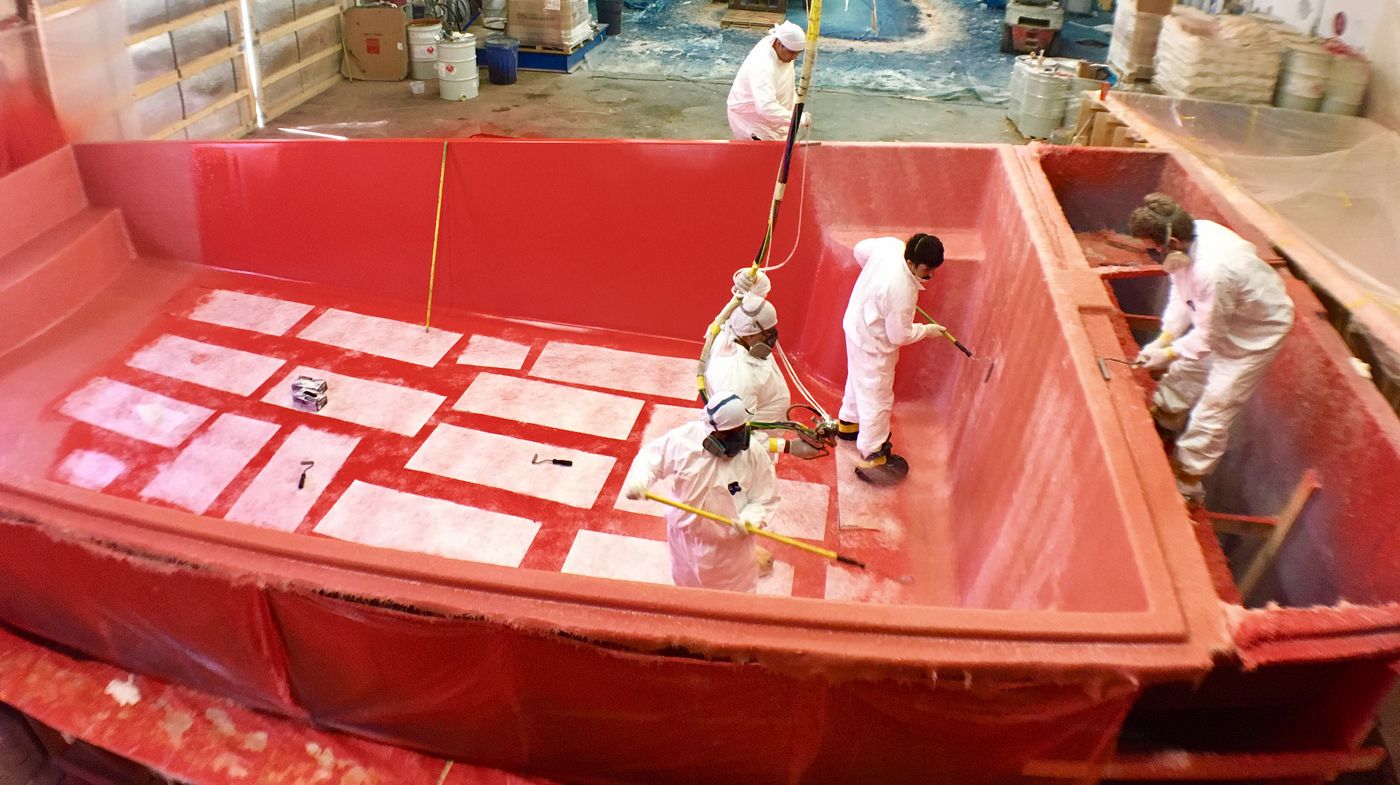
As one of the leading manufacturers of fiberglass pool shells in America we get asked all the time, “How do you create a new fiberglass pool design from scratch?”
It’s a question we love answering because it’s a fascinating process and we honestly feel that the more informed the consumer is about the product they are buying, the happier they will be with it in the end.
With that said, there is a three-step process in the creation of a new fiberglass pool design.
3 Steps to Creating a New Fiberglass Pool Design
- The Pattern
- The Mold
- The Pool
This is a very detailed process that we can’t cover entirely in this article, but we can give you the basic concept behind the first two essential steps, constructing the pattern and producing the mold.
Step One: The Pattern
Let’s start with something simple that we’re all familiar with, like Jello. Let’s say we wanted to create a Jello dessert in a random shape, like a Darth Vader mask, for example. In order to do this, there is one item we would have to have: a Jello mold shaped like Darth Vader's mask. But where did the mold come from? There is a step prior to the production of any mold, and it is called the pattern.
The pattern is made in the exact shape of what you want your finished product to look like. So if we wanted to create a Vader Jello mold, we would first create our Vader mask in the precise shape we want our Jello to take, then we would build our mold from that. Then we would remove the mold and it would become the “tool” we need to create our delicacy from the dark side.
Fiberglass pools basically work the same way.
The creation of a new fiberglass pool design starts with a pattern. This pattern is constructed using wood, fiberglass, body filler, and primer.
When completed, the pattern is the exact shape of the finished pool.
The Pattern Must Be Level
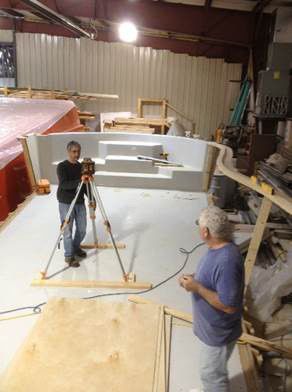 One of the biggest installation challenges with fiberglass pools is getting the pool shell level once it is set in the hole. A pool that is built level from the factory is easy to level on the job site.
One of the biggest installation challenges with fiberglass pools is getting the pool shell level once it is set in the hole. A pool that is built level from the factory is easy to level on the job site.
However, fiberglass pools that are not built level require a lot of valuable time and energy as the pool is repeatedly re-set as the installer attempts to get the pool right.
This all begins with the construction of the pattern.
If the pattern is constructed level, the mold will be level, and so will the pool that arrives in your backyard.
To the left is a picture of Bill Khamis using a laser level to ensure the pattern for the Titus fiberglass pool design is perfect.
The pattern making process typically takes between three and six months. Here is a picture of the completed Titus pattern.
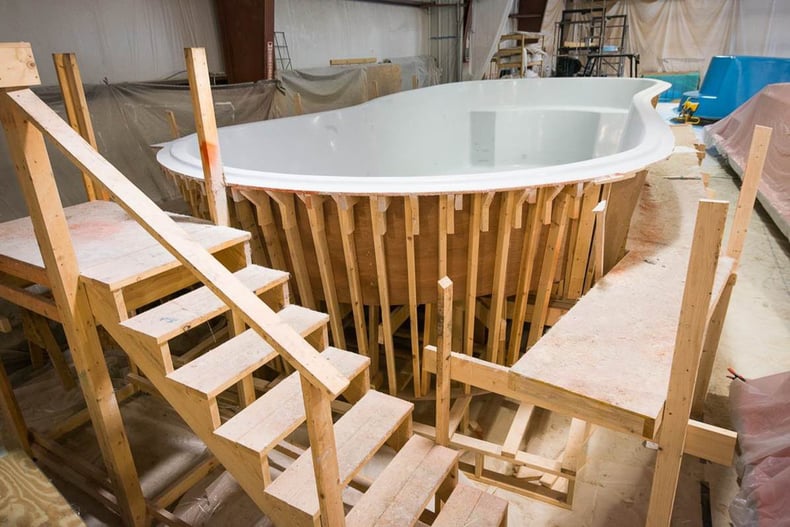
Once the pattern is complete, we are ready to begin step two, the creation of the mold.
Step Two: The Mold
In the world of fiberglass pool manufacturing, molds are everything. You can have the best facility, the best equipment, and the best people, but the quality of your pool cannot exceed the quality of your mold.
This is because the pool surface will mirror whatever defects exist in the mold.
Consequently, the mold-making process is critical to having a high quality pool. And just to be clear about this, “high quality pool” does not mean a perfect pool.
There is no such a thing as a perfect mold, or a perfect pool. If anyone tells you they produce a perfect product…watch out!
Anyway, now that we have a basic understanding of the relationship between the pattern, the mold, and the pool, let’s briefly discuss how the mold is made.
Mold production can be broken down into five phases:
- Gelcoat
- Laminate
- Frame
- Removal of the Mold from the Pattern
- Mold Preparation
Step One: Gelcoat
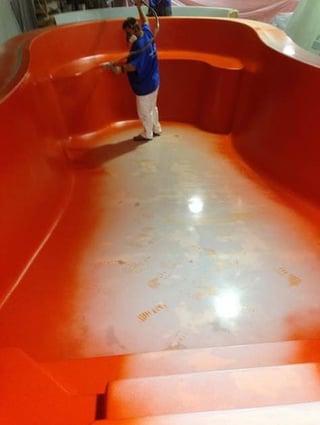 What you see in the image is the first layer of the mold, the orange tooling gelcoat, being applied to the pattern.
What you see in the image is the first layer of the mold, the orange tooling gelcoat, being applied to the pattern.
When the mold is completed and removed from the pattern, it is this surface that will separate from the white surface of the pattern once the mold is complete.
Consequently, this orange surface ends up being the outside finish of the mold; the surface that the pool shell is built on.
Step Two: Laminate
The next phase in mold construction is to add structure by applying multiple layers of fiberglass, which is what is seen in the first picture below.
Once a specified thickness is achieved, balsa wood is laid over the entire surface, followed by more fiberglass.
Balsa adds a layer of cushion that allows the mold to withstand the extreme temperature change resulting from exothermic heat from the chemical reaction that occurs when fiberglass cures.
It also protects the mold from the stresses of lifting and transporting. Using balsa in molds is common in the boat industry, however the majority of fiberglass pool manufacturers do not use balsa in their mold construction. The balsa wood is what is seen in the floor and bench of the second picture.
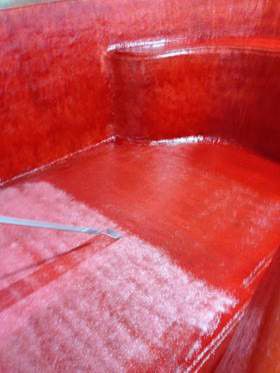
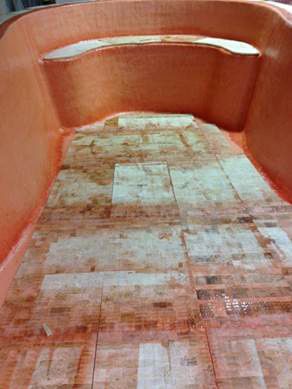
Step Three: Steel Reinforcement
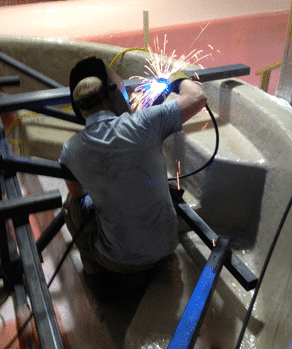 It is critical that fiberglass pool molds are properly reinforced. They are constantly under stress from maneuvering and demolding pools.
It is critical that fiberglass pool molds are properly reinforced. They are constantly under stress from maneuvering and demolding pools.
This is why it is critical that the mold have an interior frame structure that can withstand this stress and allow the mold to maintain its original shape. This is why we only use steel in our mold frame construction.
The steel frame is attached to the mold by wrapping sheets of fiberglass around sections of steel and onto the fiberglass surface of the inside of the mold.
Step 4: Removal of Mold from the Pattern
Once the steel frame is complete, it’s time to remove the mold from the pattern.
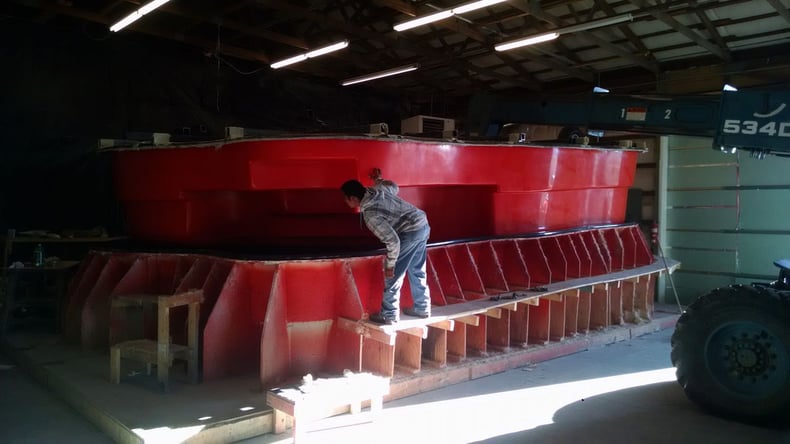
Step 5: Mold Preparation
Once removed, the mold is flipped over, orange side up, which is how it will spend the remainder of its life.
Then the surface of the mold is sanded, buffed, and treated with special sealers and release agents to prevent the pool shells that will be built on it from sticking.
Then we are ready to start building pools!
So long as a mold is properly constructed and maintained, you can build pools on it forever.
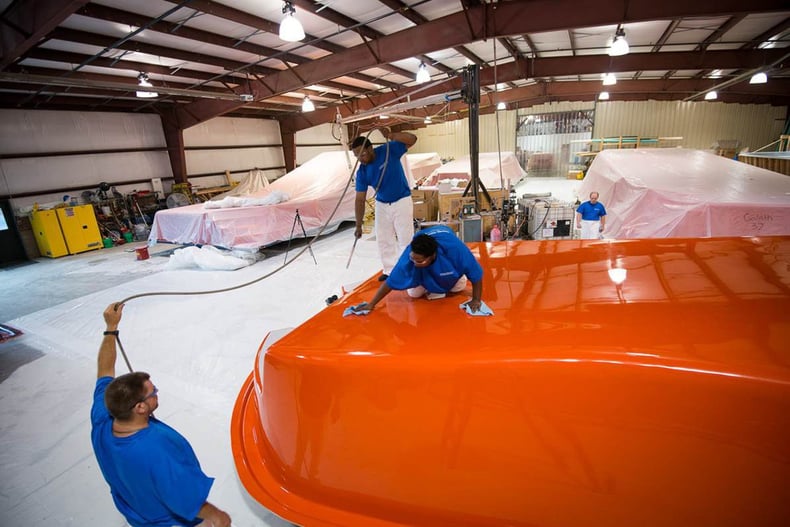
The process of building a fiberglass pool mold typically takes about one to two months from the time the pattern is complete.
Step 3: The Pool
Once we have a working mold, we can manufacture many fiberglass pools on it.
Just so you can see the end result, here is a picture of a pool shell being removed from the mold.
.png?width=248&height=309&name=pool%20shell%20separated%20from%20mold%20(smaller%20with%20labels).png)
Hopefully this has helped you understand the basic process of pattern and mold construction for fiberglass pools.
If you're interested in receiving a quote to have a fiberglass pool installed in your backyard, get in touch with us and a representative will touch base with you within 24 hours.
Finally, if you have any questions or comments please feel free, as always, to leave them below.
Up Next:
The Basics of Manufacturing and Installing a Fiberglass Pool
What Can You Expect From a Fiberglass Pool Kit?
What’s the Best Small Fiberglass Pool for Your Needs? Costs, Sizes, Features
Editor's note: This blog article was updated on February 18, 2020.
Jason Hughes is a partner at River Pools Virginia, a fiberglass pool installation company based in Warsaw, Virginia. With over 20 years of hands-on experience, Jason has dedicated his career to helping families create beautiful, functional backyards while ensuring every fiberglass pool installation meets the highest standards of quality and safety. In addition to his work with homeowners, Jason serves as a GENESIS instructor with the Pool & Hot Tub Alliance (PHTA), where he teaches fiberglass pool installation best practices to pool professionals across the country. Whether he’s on a job site or leading a training session, Jason is passionate about raising the bar for fiberglass pool installations and helping families make confident, informed decisions as they transform their outdoor spaces.
Topics:

